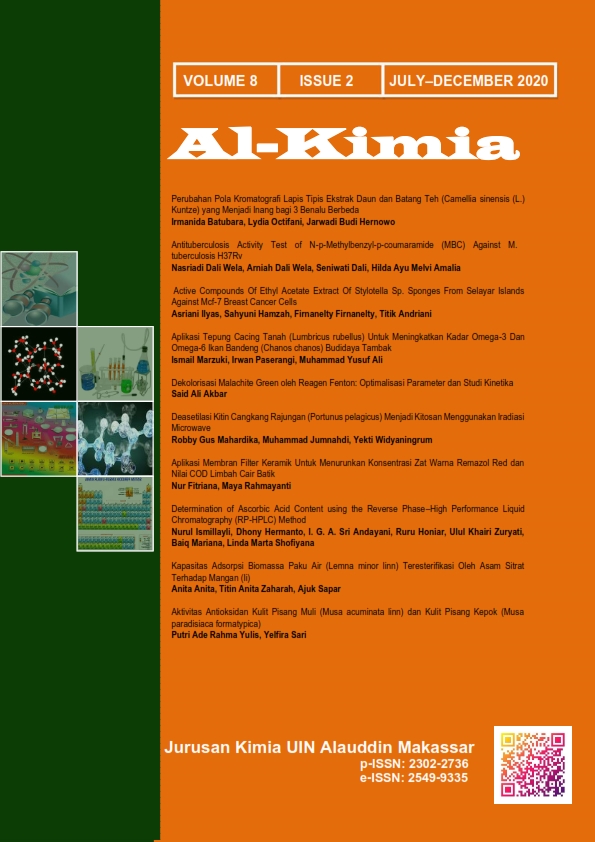Aplikasi Tepung Cacing Tanah (Lumbricus rubellus) Untuk Meningkatkan Kadar Omega-3 Dan Omega-6 Ikan Bandeng (Chanos chanos) Budidaya Tambak
Abstract
The quality of milkfish (Chanos chanos) in ponds cultivation is low. Small body size, pale body surface, odor of mud and low nutritional value cause not compete in the retail market, due to ponds experiencing burnout due to excessive use of synthetic fertilizers and pesticides. The aim of this study was improved the quality of milkfish farming with earthworm flour (Lumbricus rubellus) (TCT). Adding TCT to feed with four different treatments for 30 days. The results showed that the administration of 5%, 10% and 15% TCT, could improve the quality of milkfish ponds, both qualitative and quantitative. Qualitative improvement aspects, namely the surface of the fish's body was brighter, scales cleaner and whiter, the smell of mud was not felt, while the achievement of quantitative aspects was the fish's weight increased sharply in the range of 1.465% - 1.846% per day and omega-3 levels increased in the range of 1.9834 % - 5,5693% and omega-6 increased in the range of 1.4993% - 4.8796% or an increased of nearly 10 times each compared to levels of omega-3 and omega-6 milkfish samples without TCTDownloads
References
Alagawany, M., Elnesr, S. S., Farag, M. R., El-Hack, M. E. A., Khafaga, A. F., Taha, A. E., Dhama, K. 2019. Omega-3 and Omega-6 Fatty Acids in Poultry Nutrition : E ff ect on Production Performance and Health. Animals Review, 9, 1–19.
Amaliah, R., Hastuti, S., & Sudaryono, A. 2019. Pengaruh Pemberian tepung cacing tanah (Lumbricus sp) sebagai atraktan dalam pakan terhadap tingkat konsumsi pakan efisiensi pakan dan pertumbuhan ikan patin (Pangasius sp). Jurnal Sains Akuakultur Tropis, 3(1), 27–35.
Diana, F. M. 2012. Omega-3. Jurnal Kesehatan Masyarakat, 6(2), 113–117.
Diana, F. M. 2013. Omega-6. Jurnal Kesehatan Masyarakat, 7(1), 26–31.
Haryadi, W., & Triono, S. 2006. Fractionation of Fatty acid Omega 3,6 and 9 from Snail
(Achatina fulica) using coloum Chromatography. Indon J. Chem, 6(3), 316–321.
Iryani, A. S., & Marzuki, I. 2017. Penilaian Tingkat Cemaran Timbal pada Danau Balang Tonjong Kelurahan Antang Manggala, Kota Makassar. Jurnal Technoi Entrepreneur Acta, 2(1), 52–52.
Isnaeni, W., Fitriyah, A., & Setiati, N. 2010. Pengaruh Pemberian Omega-3 , Omega-6, dan Kolesterol Sintetis terhadap Kualitas
Reproduksi Burung Puyuh Jantan. Biosaintifika Jurnal, 2(1), 40–52.
Julendra, H., Zuprizal, & Supadmo. 2010. Penggunaan tepung cacing tanah (Lumbricus rubellus) sebagai Aditif pakan terhadap penampilan produksi Ayam pedaging, Profil Darah dan kecernaan protein. Buletin Peternakan, 34(1), 21–29.
Kusumawati, D., Jamaris, Z., & Aslianti, T. 2017. Profil Pertumbuhan, Enzimatis dan Nutrisi Ikan Bandeng (Chanos chanos) Generasi Kedua (G-@) Terseleksi dengan Menerapkan Standar Operasional Prosedur (SOP) Pemeliharaan Larva. Media Akuakultur, 12(2), 55–66.
Leo, B., Raharjo, E. I., & Farida. 2016. Combination of Feed and Lumbricul Rubellus on the Growth Rate and survival rate Fish Ringau (Datniodes mesrolepis). Perikanan Kelautan, 4(2), 1–8.
Marzuki, I., Harlim, T., & Ubbe, U. 2003. Daya Hambat Ekstrak Alga Coklat Jenis Sargassum terhadap Proses Pematangan Buah dan Sayur. Marina Chimica Acta, 4(2), 18–24.
Marzuki, I., Noor, A., Nafie, N. La, & Djide, M. N. 2016. Morphological and phenotype analysis of microsymbiont and biomass marine sponge from melawai beach, Balikpapan, east kalimantan. International Journal Marina Chimic Acta, 17(1), 8–15.
Marzuqi, M., Andamari, R., Wayan, N., Astuti, W., Andriyanto, W., & Nyoman Adiasmara Giri. 2018. Peningkatan produksi dan kualitas telur induk bandeng (Chanos chanos) dengan penambahan Bahan Pengkaya pada Pakan. Media Akuakultur, 13(1), 11–19.
Marzuqi, M., Kasa, I. W., & Giri, N. A. 2019. Respon pertumbuhan dan aktivitas enzim Amilaze benih ikan Bandeng ( Chanos chanos Forsskal ) yang diberi Pakan dengan kandungan karbohidrat yang berbeda. Media Akuakultur, 14(1), 31–39.
Ningsih, T. R., Redjeki, E. S., & Luthfiyah, S. 2018. Pemberian Berbagai Dosis Probiotik pada Pakan Terhadap Pertumbuhan dan FCR Ikan Bandeng (Chanos chanos) dengan Sistem Polikultur. Jurnal Perikanan Pantura, 1(2), 17–21.
Nisa, F. Z., Probosari, E., & Deny Yudi Fitranti. 2017. Hubungan asupan Omega-3 dan Omega-6 dengan kadar trigliserida pada remaja 15-18 tahun. Journal of Nutrition College, 6(2), 191–197.
Rasyid, A., & Zulharnah. 2003. Asam Lemak Omega-3 dari Minyak Ikan. Oseana Journal, XXVIII(3), 11–16.
Romadon, A., & Subekti, E. (2011). Teknik Budidaya Ikan Bandeng di Kabupaten Demak. MEDIAGRO Jurnal, 7(2), 19–24.
Sari, M. L., Probosari, E., & Sandi, H. (2017). Hubungan asupan asam lemak omega-3 dan omega-6 dengan tekanan darah wanita usia 30-50 tahun. Journal of Nutrition College, 6(4), 313–318.
Suzan, R., & Halim, R. (2018). Korelasi asupan asam lemak omega-3 dengan kemampuan kognisi mahasiswa kedokteran. Jambi Medical Journal, 6(2), 146–151.
Taris, M. R., Santoso, L., & Harpeni, E. (2018). Pengaruh Subtitusi Tepung Ikan Dengan Tepung Cacing Tanah (Lumbricus sp.) terhadap Pertumbuhan benur Udang Windu (Penaeus monodon). Jurnal Rekayasa Dan Teknologi Budidaya Perairan, VI(2), 699–704.
Authors who publish with this journal agree to the following terms:
1) Authors retain copyright and grant the journal right of first publication with the work simultaneously licensed under a Creative Commons Attribution License that allows others to share the work with an acknowledgement of the work's authorship and initial publication in this journal.
2) Authors are able to enter into separate, additional contractual arrangements for the non-exclusive distribution of the journal's published version of the work (e.g., post it to an institutional repository or publish it in a book), with an acknowledgement of its initial publication in this journal.
3)Authors are permitted and encouraged to post their work online (e.g., in institutional repositories or on their website) prior to and during the submission process, as it can lead to productive exchanges, as well as earlier and greater citation of published work (See The Effect of Open Access).


